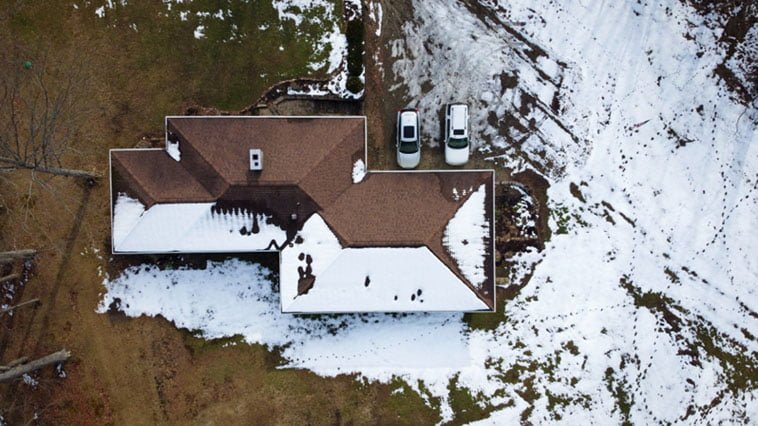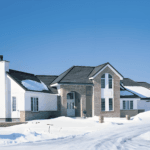Snow has recently started falling here, how about where you are? Your chilly winter is always accompanied by SKW Roof. Wishing you a joyful and carefree winter season!
Winter is a challenging season for homeowners, especially when it comes to protecting their roofs from the harsh weather conditions. Freezing temperatures, heavy snow loads, and ice dams can all pose significant threats to the integrity of a roof. By taking proactive measures to maintain and prepare your roof for winter, you can ensure its longevity and protect your home from potential damage. In this comprehensive guide, we will explore the key steps to maintaining your roof during extreme cold weather in winter.
1. Visual Inspection: Assessing the Health of Your Roof
Before winter sets in, it’s essential to conduct a thorough visual inspection of your roof. While metal roofs are known for their durability, they are not invulnerable to damage. Freeze-thaw cycles can exacerbate the risks created by moisture penetrating roofing materials, making it crucial to look for any signs of damage. Inspect the panels, flashings, and seams for any marred areas. If you notice any issues or are unsure about the condition of your roof, it’s recommended to seek a professional’s opinion for a thorough and accurate assessment.
2. Snow Guards: Preventing Dangerous Snow Accumulation
While metal roofs are efficient at shedding snow, heavy snowfall can be dangerous if large clumps of snow and ice slide off without warning. To mitigate the risk of property damage and personal injury, consider installing snow guards. These devices regulate the rate at which roofs shed snow and ice, preventing sudden avalanches.
3. Trim Overhanging Tree Branches: Minimize Debris and Potential Damage
Overhanging tree branches can pose a threat to your roof, especially during winter storms. Heavy snowfall and strong winds can cause branches to break and fall onto your roof, potentially causing damage to the shingles, flashings, or even the roof’s structure. To minimize the risk of damage, trim any overhanging branches before winter arrives. By doing so, you can prevent fallen debris from collecting on your roof and reduce the likelihood of branches striking your roof during inclement weather.
4. Clean the Gutters: Ensure Proper Water Drainage
Cleaning the gutters is an essential step in preparing your roof for winter. During the fall season, leaves, twigs, and other debris can accumulate in the gutters, obstructing proper water drainage. If the gutters are clogged, melting snow and ice won’t be able to flow freely, potentially leading to ice damming and water damage. Regularly cleaning the gutters helps mitigate these issues and ensures that your roof stays strong and intact during even the harshest weather conditions.
5. Seal Attic Leaks: Preventing Heat Loss and Water Infiltration
In addition to insulation, it’s important to seal any air leaks, gaps, or cracks in the attic. These openings can allow warm air to escape, leading to heat loss and potential water infiltration. Proper sealing helps maintain a stable temperature in the attic, preventing the formation of ice dams and minimizing the risk of damage to your roof and home. By addressing attic leaks, you can also improve energy efficiency and reduce heating costs.
6. Install Roof Heating Cables: Combating Ice Dams
Roof heating cables can be a valuable addition to your winter roof maintenance strategy. These cables are typically installed along the eaves and gutters to prevent ice dams from forming. They work by melting snow and ice, creating a clear path for water to drain off the roof. If ice dams have been a recurring issue in the past, consider installing roof heating cables to minimize the risk of damage caused by ice dams.
7. Check Flashing and Seals: Ensure Proper Waterproofing
Inspecting the flashing around chimneys, vents, and other roof penetrations is crucial for maintaining proper waterproofing. Over time, flashing can deteriorate or become damaged, compromising its ability to protect against water infiltration. Check for signs of wear or damage and ensure that all seals are tight. If you notice any issues, it’s recommended to address them promptly to prevent water damage and maintain the integrity of your roof.
8. Consider Upgrading Your Roof: Investing in Long-Term Protection
If your roof is nearing the end of its lifespan or has significant damage, it may be worth considering a roof upgrade before winter arrives. Upgrading to a new roof ensures that you have a sturdy and well-installed system that can provide optimal protection against winter weather. Consult with a professional roofing contractor to determine the best course of action based on the condition of your current roof and your specific needs.
9. General Roof Maintenance Tips: Extending Roof Lifespan
Beyond preparing your roof specifically for winter, there are general maintenance tips that can help extend its lifespan and keep it in excellent condition year-round:
- Regularly clean debris: Perform periodic roof cleanings to remove leaves, branches, and other debris that can accumulate over time. A clean roof is less likely to develop leaks and other issues.
- Schedule annual inspections: Hire a professional roofing contractor to conduct annual roof inspections. These inspections can identify and address any problems early, saving you from costly repairs down the line.
- Maintain proper ventilation: Ensure that your roof has proper ventilation to prevent excess heat buildup in the attic, which can lead to shingle damage and other issues.
- Promptly repair damage: If you notice any signs of roof damage, such as leaks or missing shingles, don’t delay in getting them repaired. Timely repairs can prevent minor issues from becoming major problems.
- Consider roof coatings: Roof coatings can provide an extra layer of protection against the elements and extend the lifespan of your roof. Consult with a professional to determine if a roof coating is suitable for your home.
10. Additional Tips for Winter Roof Maintenance: Snow Removal and Safety
In regions with heavy snowfall, removing snow from your roof can help prevent excessive weight and potential structural damage. However, it’s crucial to prioritize safety when engaging in snow removal. Avoid using sharp tools or harsh chemicals that can damage the roof. Instead, opt for snow rakes or brooms with soft bristles to gently remove snow. If you’re unsure about the proper snow removal techniques, it’s best to consult a professional to ensure both the safety of your roof and yourself.
11. Conclusion: Protecting Your Roof During Extreme Cold Weather
Maintaining your roof during extreme cold weather in winter is essential for protecting your home and ensuring its longevity. By conducting regular inspections, addressing any damage or potential issues, and following proper maintenance practices, you can minimize the risk of roof damage, leaks, and other winter-related problems. Remember to consult with a professional roofing contractor for expert advice and assistance in maintaining your roof. With proper care and attention to your roof’s needs, you can face the winter season confidently, knowing that your roof is prepared to withstand the harshest weather conditions.




